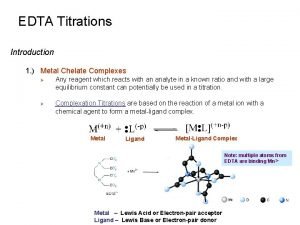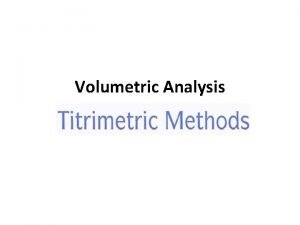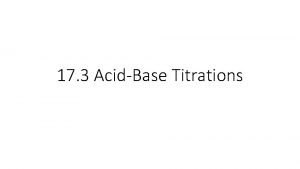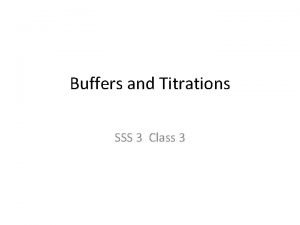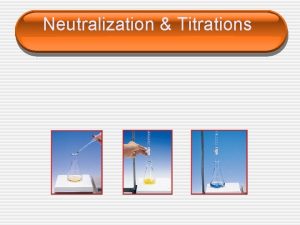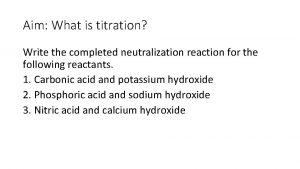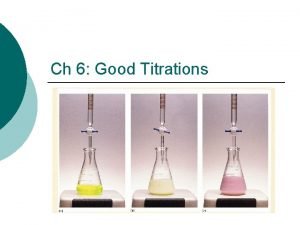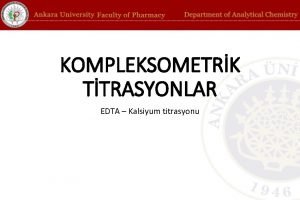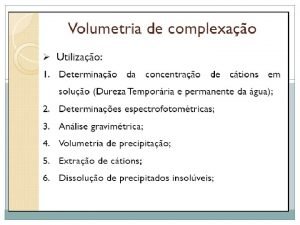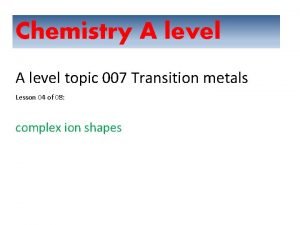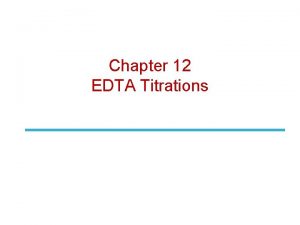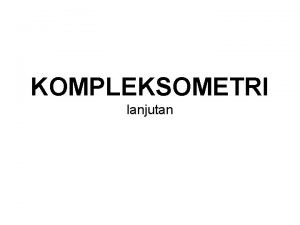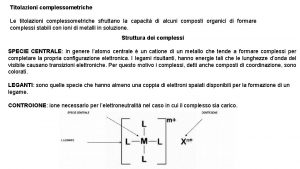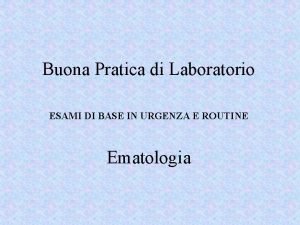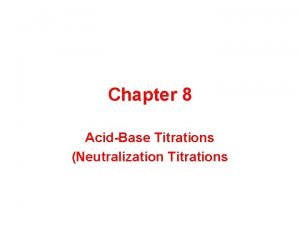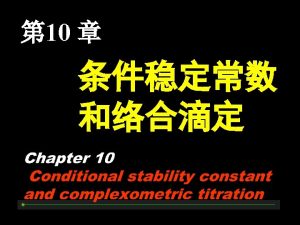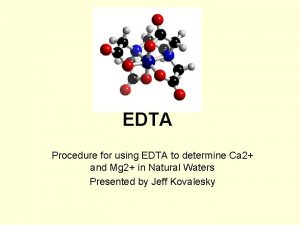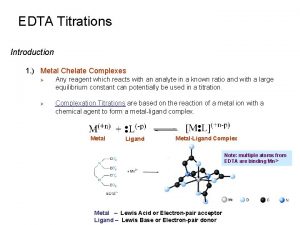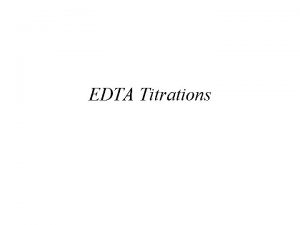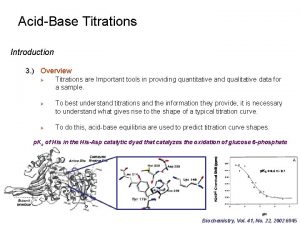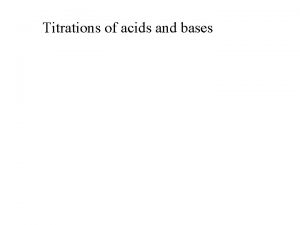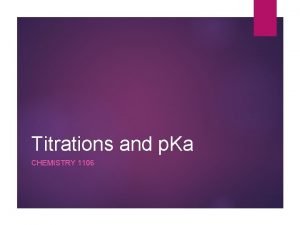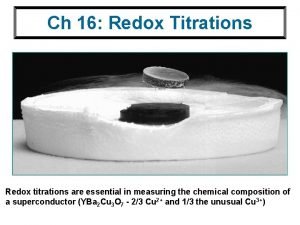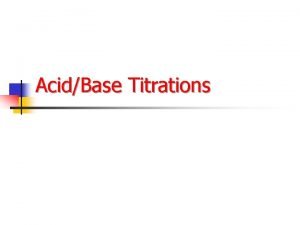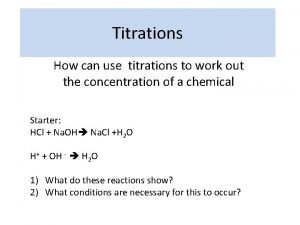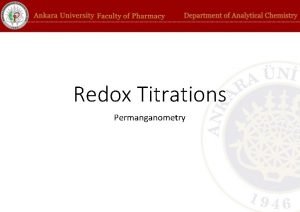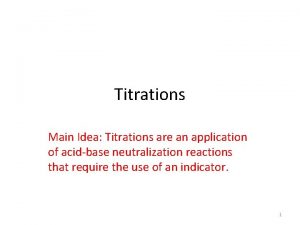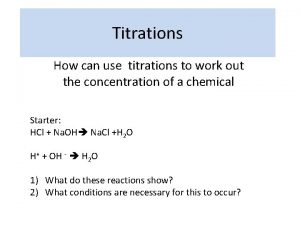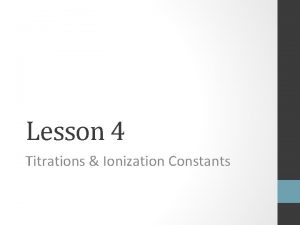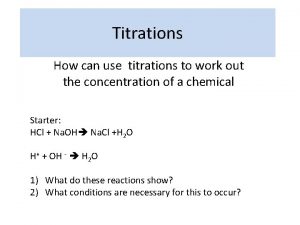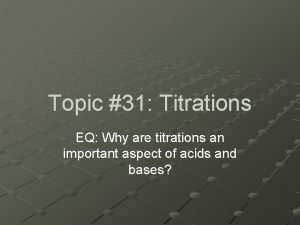Chapter 12 EDTA Titrations Overview 12 1 MetalChelate

























![12 -4: Do It with a Spreadsheet Substituting Kf[M][L] from Equation 12 -8 for 12 -4: Do It with a Spreadsheet Substituting Kf[M][L] from Equation 12 -8 for](https://slidetodoc.com/presentation_image/00cd6ac0ccd7853dd0a3f99557b89ec1/image-26.jpg)



![12 -5: Metal-Ligand Equilibria • The mass balance is: Mtot = [M] + [ML 12 -5: Metal-Ligand Equilibria • The mass balance is: Mtot = [M] + [ML](https://slidetodoc.com/presentation_image/00cd6ac0ccd7853dd0a3f99557b89ec1/image-30.jpg)












- Slides: 42

Chapter 12 EDTA Titrations

Overview 12 -1 Metal-Chelate Complexes 12 -2 EDTA 12 -3 EDTA Titration Curves 12 -4 Do It with a Spreadsheet 12 -5 Auxiliary Complexing Agents 12 -6 Metal Ion Indicators 12 -7 EDTA Titration Techniques

12 -2: EDTA • Ethylenediaminetetraacetic acid (EDTA) is a compound that forms strong 1: 1 complexes with most metal ions. • Used in industrial processes and products such as detergents, cleaning agents, and food additives that prevent metal-catalyzed oxidation of food. • Metal-EDTA complexes find their way into the environment because they can pass through wastewater treatment plants unscathed.

12 -1: Metal-Chelate Complexes • Metal ions are Lewis acids that accept electron pairs from electron-donating ligands (Lewis bases). • Monodentate ligands bind to a metal ion through only one atom (e. g. , CN- through the C atom). • A ligand that attaches to a metal ion through more than one ligand atom is said to be multidentate, or a chelating agent.

12 -1: Metal-Chelate Complexes • Ethylenediamine is a simple chelating agent, which is bidentate. • Chelate effect – the ability of multidentate ligands to form more stable metal complexes than those formed by similar monodentate ligands.

12 -1: Metal-Chelate Complexes The reaction of with two molecules of ethylenediamine is more favorable than its reaction with four molecules of methylamine, a monodentate ligand:

12 -1: Metal-Chelate Complexes Adenosine triphosphate (ATP) is an important tetradentate ligand, which binds divalent metal ions (Mg 2+, Mn 2+, Co 2+, and Ni 2+) through four of their six coordination positions. The fifth and sixth positions are occupied by water molecules.

12 -1: Analytically Useful Chelating Agents

12 -2: EDTA • A titration based on complex formation is called a complexometric titration. • EDTA is the most widely used chelator in analytical chemistry. • By direct titration or through an indirect series of reactions, virtually every element of the periodic table can be measured with EDTA.

12 -2: EDTA: Acid-Base Properties EDTA is a hexaprotic system, designated H 6 Y 2+. The first four p. K values apply to carboxyl protons; the last two are for the ammonium protons. The neutral acid is tetraprotic, with the formula H 4 Y, which can be dried at 140 o. C for 2 h and used as a primary standard.

12 -2: EDTA: Acid-Base Properties The fraction of EDTA in each of its protonated forms is plotted in the figure:

12 -2: EDTA: Acid-Base Properties We can define a for each species as the fraction of EDTA in that form. For example, a. Y 4 - is defined as: where [EDTA] is the total concentration of all free (not complexed to metals) EDTA species in the solution. Therefore, a. Y 4 - is given by:

12 -1: Example: What Does a. Y 4 Mean?

12 -2: EDTA Complexes The equilibrium constant for the reaction of a metal with a ligand is called the formation constant, Kf, or the stability constant: Kf for EDTA is defined in terms of the species Y 4 reacting with the metal ion.

12 -2: EDTA Complexes The table shows that formation constants for most EDTA complexes are large and tend to be larger or more positively charged cations.

12 -2: Conditional Formation Constant • Most EDTA is not Y 4 - below p. H 10. 37. The species HY 3 - and H 2 Y 2 -, and so on, predominate at lower p. H. • If the p. H is fixed by a buffer, then a. Y 4 - is a constant that can be combined with Kf: • This is called the conditional formation constant and it describes the formation of MYn-4 at any particular p. H.

12 -2: Conditional Formation Constant

12 -3: EDTA Titration Curves • We can calculate the n+ concentration of free M during its titration with EDTA: • If is large, we can consider the reaction to be complete at each point in the titration. • The titration curve is a plot of p. M versus the volume of EDTA added and has three natural regions.

12 -3: EDTA Titration Curves Region 1: Before the Equivalence Point • The concentration of free metal is equal to the concentration of excess, unreacted Mn+. Region 2: At the Equivalence Point • [Mn+] = [EDTA] Region 3: After the Equivalence Point • The concentration of free EDTA can be equated to the concentration of excess EDTA added after the equivalence point.

12 -3: Titration Calculations Consider the reaction of 50. 0 m. L of 0. 040 0 M Ca 2+ (buffered to p. H 10. 00) with 0. 080 0 M EDTA. Region 1: Before the Equivalence Point • After the addition of 5. 0 m. L of EDTA

12 -3 Titration Calculations Region 2: At the Equivalence Point • Virtually all the metal is in the form Ca. Y 2 -. [Ca. Y 2 -] is equal to the original [Ca 2+] with a correction for dilution. • The concentration of free Ca 2+ is small and unknown.

12 -3 Titration Calculations

12 -3 Titration Calculations Region 3: After the Equivalence Point • Virtually all of the metal is in the form Ca. Y 2 -, and there is excess, unreacted EDTA. • After the addition of 26. 0 m. L of EDTA, there is 1. 0 m. L of excess EDTA.

12 -3 Titration Calculations The concentration of Ca 2+ is governed by:

12 -4: Do It with a Spreadsheet Consider the titration of metal ion M (initial concentration = CM, volume VM) with a solution of ligand L (concentration = CL, volume added = VL) to form a 1: 1 complex: The mass balances for metal and ligand are:
![12 4 Do It with a Spreadsheet Substituting KfML from Equation 12 8 for 12 -4: Do It with a Spreadsheet Substituting Kf[M][L] from Equation 12 -8 for](https://slidetodoc.com/presentation_image/00cd6ac0ccd7853dd0a3f99557b89ec1/image-26.jpg)
12 -4: Do It with a Spreadsheet Substituting Kf[M][L] from Equation 12 -8 for [ML] in the mass balance: Now substitute the expression for [L] from Equation 12 -10 back into Equation 12 -9, then solve for the fraction of titration, .

12 -4: Do It with a Spreadsheet The equation for titrating L with M:

12 -5 Auxiliary Complexing Agents • For many metals to be titrated in alkaline solutions with EDTA, we use an auxiliary complexing agent to prevent metal hydroxide precipitation. • Reagents are ligands such as ammonia, tartarate, citrate, or triethanolamine • They must bind strongly enough to prevent metal hydroxide from precipitating, but weakly enough to give up the metal when EDTA is added.

12 -5: Metal-Ligand Equilibria • Consider a metal ion that forms two complexes with the auxiliary complexing ligand L: • b are the cumulative formation constants. • The fraction of metal ion in the uncomplexed state, M, is: • Where Mtot is the total concentration of all forms of M (M, ML, and ML 2).
![12 5 MetalLigand Equilibria The mass balance is Mtot M ML 12 -5: Metal-Ligand Equilibria • The mass balance is: Mtot = [M] + [ML](https://slidetodoc.com/presentation_image/00cd6ac0ccd7853dd0a3f99557b89ec1/image-30.jpg)
12 -5: Metal-Ligand Equilibria • The mass balance is: Mtot = [M] + [ML 2] • Equations 12 -13 and 12 -14 allow us to say [ML] = b 1[M][L] and [ML 2] = b 2[M][L]2 • Therefore, Mtot = [M] + b 1[M][L] + b 2[M][L]2 = [M]{1 + b 1[L] + b 2[L]2} • Substituting into Equation 12 -15:

12 -5: Metal-Ligand Equilibria

12 -5: EDTA Titration in the Presence of Ammonia • Consider the titration of Zn 2+ by EDTA in the presence of NH 3. • We now need a new conditional formation constant to account for the fact that only some of the EDTA is in the form Y 4 - and only some of the zinc not bound to EDTA is in the form Zn 2+:

12 -5: EDTA Titration in the Presence of Ammonia

12 -5: EDTA Titration in the Presence of Ammonia

12 -5: EDTA Titration in the Presence of Ammonia

12 -6: Metal Ion Indicators End-point detection methods: 1. Metal ion indicators (most common) 2. Mercury electrode 3. Ion-selective electrode 4. Glass (p. H) electrode • Metal ion indicators are compounds that change color when they bind to a metal ion – must bind metal less strongly than does EDTA. • Example: the reaction of Mg 2+ with EDTA at p. H 10 with Calmagite indicator.

12 -6: Metal Ion Indicators

12 -6: Metal Ion Indicators

12 -7: EDTA Titration Techniques 1. Direct titration: Analyte is titrated with standard EDTA. Analyte is buffered to a p. H where for the metal-EDTA complex is large and the color of the free indicator is different than that of the metal -indicator complex. 2. Back titration: A known excess of EDTA is added to the analyte. Excess EDTA is then titrated with a standard solution of a second metal ion.

12 -7: EDTA Titration Techniques

12 -7: EDTA Titration Techniques 3. Displacement Titration: Use when the analyte, such as Hg 2+, does not have a satisfactory indicator. • Hg 2+ is treated with excess Mg(EDTA)2 - to displace Mg 2+, which is titrated with standard EDTA. There is also no suitable indicator for Ag+, however Ag+ will displace Ni 2+ from tetracyanonickelate(II) ion: 2 Ag+ + Ni(CN)42 - → 2 Ag(CN)2 - + Ni 2+ The Ni 2+ liberated can be titrated with EDTA to determine the amount of Ag+ added.

12 -7: EDTA Titration Techniques 4. Indirect Titration: Anions that precipitate with certain metal ions can be analyzed with EDTA using an indirect titration. Example: Sulfate can be analyzed by precipitation with excess Ba 2+ at p. H 1. • Ba. SO 4 (s) is washed then boiled with excess standard EDTA at p. H 10 to bring Ba 2+ back into solution as Ba(EDTA)2 -. • Excess EDTA is back-titrated with Mg 2+. 5. Masking: A masking agent is a reagent that protects a component of the analyte from reaction with EDTA. Example: Al 3+ in a mixture of Mg 2+ and Al 3+ can be measured by masking the Ag+ with F-, leaving only the Mg 2+ to react with EDTA.
 Example of auxiliary complexing agent
Example of auxiliary complexing agent Types of volumetric analysis
Types of volumetric analysis Types of titrations
Types of titrations Titration vs back titration
Titration vs back titration Precipitation titration curve
Precipitation titration curve Weak acid strong base buffer
Weak acid strong base buffer Neutralization titrations
Neutralization titrations Totration formula
Totration formula Good titrations
Good titrations Edta titrasyonu
Edta titrasyonu Dissociao
Dissociao Edta complex
Edta complex Masking agent example
Masking agent example Sekuestran adalah
Sekuestran adalah Kurva titrasi kompleksometri
Kurva titrasi kompleksometri Edta tube
Edta tube Titolazione complessometrica con edta
Titolazione complessometrica con edta Titolazione edta con caco3
Titolazione edta con caco3 Lewis structure of edta
Lewis structure of edta Pseudopiastrinopenia da edta
Pseudopiastrinopenia da edta Edta stability at room temperature
Edta stability at room temperature A 23 year old male experienced severe head trauma
A 23 year old male experienced severe head trauma Chapter 14 medical overview
Chapter 14 medical overview Chapter 9 lesson 2 photosynthesis an overview
Chapter 9 lesson 2 photosynthesis an overview Chapter 12 selling overview
Chapter 12 selling overview Financial intermediaries
Financial intermediaries Chapter 1 overview of verb tenses
Chapter 1 overview of verb tenses Overview of personal finance chapter 1
Overview of personal finance chapter 1 Mesioclusion
Mesioclusion Chapter 1 overview of personal finance answers
Chapter 1 overview of personal finance answers General features of animals
General features of animals Chapter 1 an overview of financial management
Chapter 1 an overview of financial management Chapter 17 overview elements and their properties
Chapter 17 overview elements and their properties Chapter 1 overview of financial statement analysis
Chapter 1 overview of financial statement analysis Www overview
Www overview Maximo overview
Maximo overview Universal modelling language
Universal modelling language Uml
Uml Vertical overview
Vertical overview Figure 12-1 provides an overview of the lymphatic vessels
Figure 12-1 provides an overview of the lymphatic vessels Pulmonary circulation diagram
Pulmonary circulation diagram Texas public school finance overview
Texas public school finance overview Walmart company introduction
Walmart company introduction
